Growing garlic in containers can be easy if you follow this guide.
More and more gardeners are enjoying the benefits of growing garlic in their garden.
You don’t need a full in-ground garden to grow garlic. In fact, with the help of pots and containers and the know-how to plant this herb, you can grow garlic in containers either indoors or outdoors, if you have limited space.
Garlic is the perfect addition to soups, sauces, meats, and veggies. It can make any dish taste more savory, and can even be used for wounds and health purposes, as well.
Table of Contents
Growing Garlic in Containers
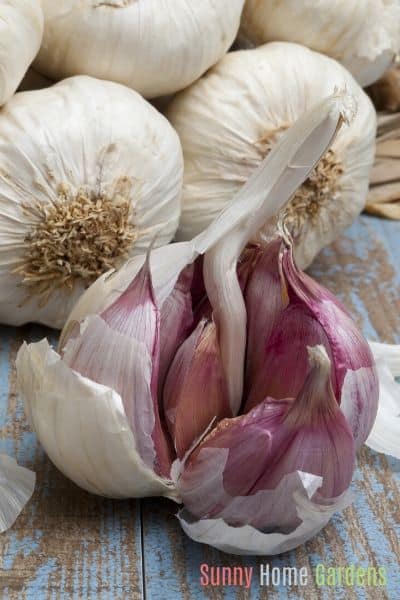
Why Should You Grow Garlic In A Containers?
Planting garlic indoors is an ideal project for any seasoned or beginning gardener.
You have the ability to grow different varieties of garlic at the same time.
Planting in pots and containers and placing them indoors can also limit your plant’s exposure to insects and diseases.
Growing in containers is a great option for a lot of vegetables. You can easily move them indoors when the weather gets too cold, and you can move them around more easily to get more or less sun and shade.
Because garlic is prone to fungal root diseases you can more easily control the growing medium, environment, water, and fertilization much more closely when growing it in pots.
What You Need To Grow Garlic In A Container
Pot or Container
Before you start planting, you need to choose your container.
The ideal pot is at least eight inches deep and has holes at the bottom for drainage.
If you want to plant more than one garlic bulb in a container, it should be big enough to accommodate cloves which are four inches apart from each other and four inches away from the side of the pot.
Garlic Bulb
To start garlic you need garlic cloves. You can get garlic cloves from the garlic you purchase at the grocery store, a garden, or a plant nursery.
But don’t get confused between a clove and a bulb. The entire mass of cloves is called a bulb.
So you’ll need to plant a clove to grow a bulb. Each clove when planted well and maintained properly should grow one bulb full of cloves.
It is ideal to get your bulbs from your local gardening supply store. Although grocery stores may be more accessible, often what you would find there are chemically treated, which could result in poor plant growth and may even keep it from sprouting at all.
What Are The Basics Of Growing Garlic?
Garlic is one of the easiest plants to grow.
They are pest resistant and they require very minimal care.
Although there is not a lot of effort needed to grow garlic in containers, you still need to have the basic necessities in order to produce a bountiful yield.
Fertile And Well-Draining Soil
If you are planting plants in containers, soil is one of the most important aspects of the growing process.
You don’t want to use potting soil for growing garlic bulbs in containers as it’s too heavy.
Be sure to use potting mix when growing in containers as it is lighter which allows roots to spread, as well as allows water to drain easily avoiding the fungal root diseases mentioned above.
Since garlic is known as a heavy feeder, the soil you use needs to be rich in nutrients. You’ll also need to provide a steady supply of nutrition during the growth process.
You need to use premium, fertile, and well-draining potting mix mixed with bone meal, earthworm castings, or other organic fertilizer to provide a steady stream of nutrients for your plants to flourish.
Make sure that the soil has excellent drainage too.
Garlic cannot tolerate soggy soil as it can lead to root rot. To provide proper drainage for the soil, use a potting mix mixed with perlite.
Sunlight
For the garlic to yield well, it should receive at least six to eight hours of full sunlight on a daily basis. The best place for your garlic pots would be in a south-facing area.
Make sure you place it in full sun, in a rich, well-draining, loose soil for the best results.
How To Plant Garlic in Pots
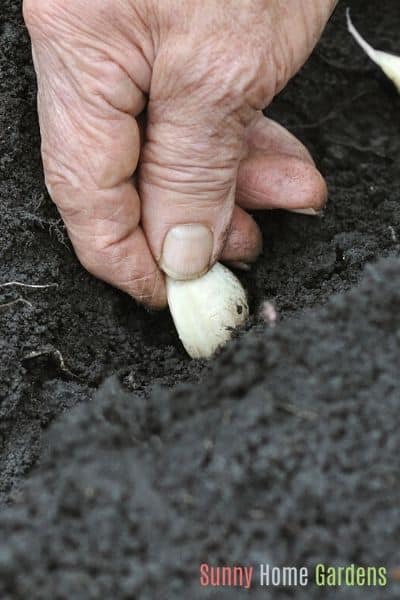
Once you have all the necessary tools needed, planting garlic in pots and containers is easy.
1. Fill the container with potting mix, up to three inches from the top of the container. You want to ensure that the soil is filled with nutrients, so be sure to mix in a slow-release fertilizer before you start planting.
2. Take the bulb of garlic and separate the cloves.
3. Place the cloves, with the pointy end up, in the potting soil. If you are planting more than one garlic clove, make sure that they are at least three to four inches apart.
4. Cover the cloves with soil. If you are located in a colder area, cover it with at least two inches of soil. If you are in a warmer climate, up to one inch of soil is fine.
5. Pat the soil gently to cover the top of the clove.
When To Plant Garlic
The best time to plant garlic is normally between September and November in most growing zones, and in warmer climates you can even plant February to March.
Most gardeners in the US plant in October.
Winter Care
If you are located in an area with colder temperatures, you can mulch the surface of the soil when the temperature is below freezing.
Straw makes a good mulch for garlic, as does chopped up leaves and grass clippings.
Mulching will help protect it from freezing temperatures over winter and will help it maintain the nutrients as well.
Garlic doesn’t do well when it has to compete with weeds, so make sure your mulch is thick enough to keep weeds from growing through once spring begins.
Garlic Fertilization
You should consistently feed your plants with fertilizer.
Once the garlic begins to grow, you can apply fertilizer every three weeks. You can use a liquid organic fertilizer. Just be sure to follow the use instructions when preparing the mix.
How Often Should I Water?
That depends on your soil.
Before you start watering, place a bamboo stick or your finger into the soil. If it feels moist, then it doesn’t need to be watered.
However, if it feels and looks dry then it’s time to water.
Water the growing garlic to keep the soil moist, but not too wet. Sprinkle it evenly with water.
Remember, garlic is prone to root diseases and these typically occur with overwatering.
When Is The Best Time To Harvest?
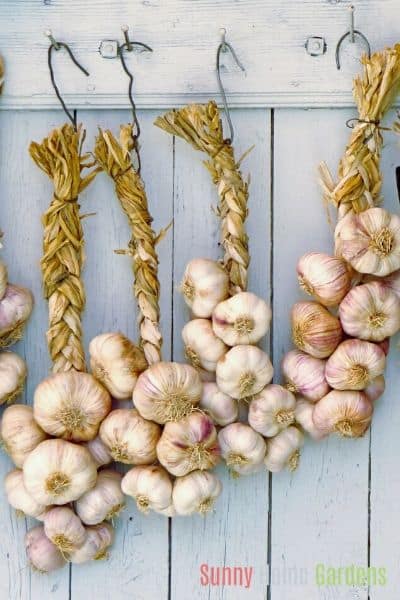
Near June you’ll see flowers begin to bud on the garlic, these are called scapes and they are edible.
You’ll want to cut these off when they start to bud to get the plant to send all its energies into growing a bigger bulb.
If you planted in fall your garlic will likely be ready to harvest in June or July, if you planted in the spring, it will be a bit later.
Keep in mind that as the garlic bulb begins to grow and spread you may see part of it emerge from the soil, this is nothing to worry about and is perfectly normal. It does not mean it’s time to harvest.
How to Harvest Garlic
Start harvesting your garlic once you see that the leaves are turning yellow and withering.
Carefully remove them from the soil, keeping them intact.
Lay them out to dry in a warm dry place, once dried you can brush off any dirt carefully.
Be careful not to break the bulbs as this will decrease their ability to be stored for a long period.
If you keep the bulb intact and don’t wait too long to harvest them, you should be able to keep the garlic for up to three months or longer.
Just because you have limited space doesn’t mean that you can’t grow garlic. You can grow garlic in containers and pots and have a bountiful yield, as long as you know how to do it.
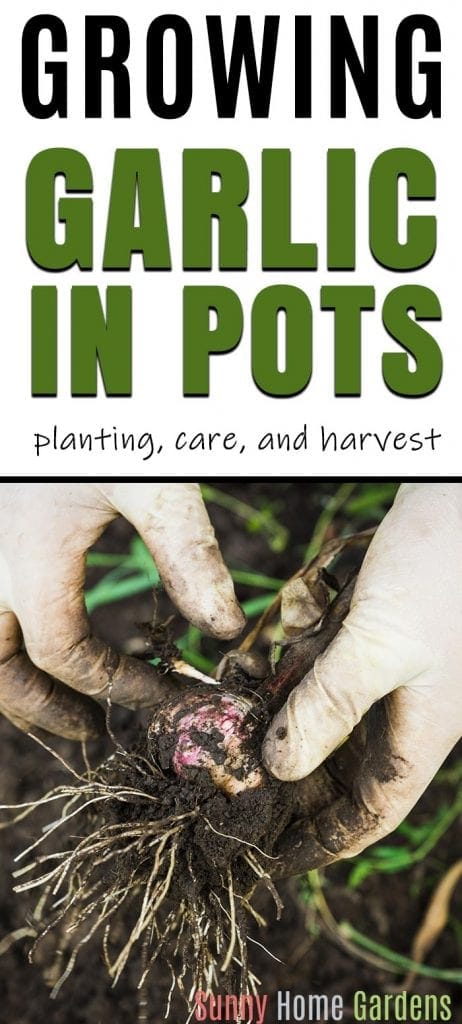


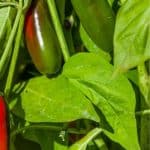

Thank you for this excellent info. I am a decades long gardener but only recently decided to grow my own garlic. I’m so glad I found your site.